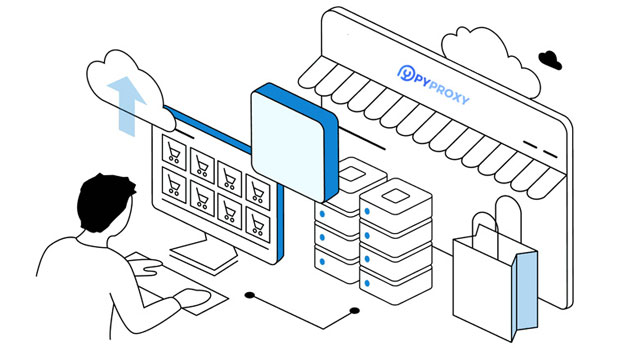How to check the difference between VPN and Proxy IP?
When navigating the digital landscape, understanding the distinction between VPN (Virtual Private Network) and proxy services is crucial, especially when it comes to managing privacy and security. Both VPNs and proxies are tools that allow users to hide their real IP addresses by routing internet traffic through remote servers. However, they work in different ways and offer different levels of security and anonymity. This article will explore how to check the difference between a VPN and a proxy ip address, explaining their core differences, how they function, and how to identify each based on specific characteristics. Understanding VPNs and Proxies: Core ConceptsBefore diving into how to differentiate VPN and proxy ips, it's essential to understand the core concepts behind both technologies.VPN (Virtual Private Network) A VPN is a secure connection between your device and a remote server through which your internet traffic is routed. This tunnel encrypts your data, providing a higher level of privacy and security. It masks your IP address and replaces it with one from the server you connect to. VPNs are commonly used for maintaining privacy, bypassing geo-restrictions, and securing sensitive data when using public networks.Proxy Server A proxy server acts as an intermediary between your device and the internet. When you use a proxy, your internet traffic is routed through the proxy server, which changes your IP address to its own. Unlike a VPN, proxies typically don’t encrypt traffic, meaning they are less secure. Proxies are often used for basic tasks such as accessing blocked content or masking IP addresses to bypass simple geographical restrictions.Key Differences Between VPN and Proxy IPsWhile both VPNs and proxies can hide your real IP address, they differ significantly in terms of functionality, security, and how they handle traffic.1. Encryption and Security A VPN offers encryption, making your internet traffic secure from potential eavesdroppers. This encryption is beneficial for protecting your data when using unsecured networks, such as public Wi-Fi. VPNs use protocols like OpenVPN, L2TP, and IPSec to ensure that data is encrypted from the moment it leaves your device until it reaches the server.Proxies, on the other hand, do not offer encryption by default. This means that data sent through a proxy can potentially be intercepted or monitored. Some advanced proxy types like HTTPS proxies may provide encryption, but they are generally not as robust as the encryption provided by VPNs.2. Traffic Routing When using a VPN, all of your internet traffic is routed through the VPN server. This includes browser activity, application data, and system processes. This comprehensive routing ensures that all your online actions are hidden behind the VPN server’s IP address.In contrast, a proxy server only routes traffic from specific applications or services. For example, a web proxy may only route traffic from your web browser, leaving other applications like email clients or instant messaging programs exposed with your real IP address. This limitation means that proxies are often less effective at maintaining complete privacy.3. Anonymity and IP Address Masking Both VPNs and proxies mask your real IP address, but they do so differently. A VPN replaces your IP address with one from the VPN server, providing anonymity for all your online activities. However, this change is typically harder to detect since all your traffic is encrypted and routed through the VPN.Proxies, however, are easier to detect because they don’t encrypt traffic. Websites and services can often detect proxy usage by checking for inconsistencies in IP addresses or looking for patterns of proxy server activity. Since proxies don’t encrypt traffic, they don’t offer the same level of anonymity as VPNs.How to Identify Whether an IP Address is from a VPN or ProxyIdentifying whether an IP address belongs to a VPN or proxy can be crucial for businesses, network administrators, and users concerned with privacy. There are several methods for checking and identifying the type of IP in use.1. IP Geolocation Tools One way to check whether an IP address belongs to a VPN or proxy is by using IP geolocation tools. These tools can help identify the location of an IP address and whether it corresponds to a known VPN or proxy server. Many VPN services use large pools of IP addresses, which can sometimes be flagged as VPN-related in geolocation databases. Proxy IPs, especially those used for web scraping or bypassing content filters, are also commonly listed in such databases.2. DNS and WebRTC Leak Tests For VPN users, DNS or WebRTC leaks may reveal the actual IP address despite using a VPN. DNS leaks occur when your device makes DNS requests directly to your Internet Service Provider (ISP) rather than the VPN server, revealing your real location. Similarly, WebRTC leaks can expose your local IP address even when connected to a VPN. Running leak tests can help determine whether your VPN connection is working properly.Proxies do not suffer from DNS or WebRTC leaks in the same way, as they generally don't involve direct interactions with DNS servers. However, proxies can still be detected by checking for inconsistencies in the source IP address or by inspecting HTTP headers that might reveal proxy server usage.3. Behavioral Patterns and Traffic Analysis Another method to distinguish between a VPN and a proxy IP is by analyzing traffic patterns. VPNs often produce encrypted traffic, which can be detected by specialized tools that analyze network traffic. Proxy traffic, on the other hand, is often easier to identify due to the lack of encryption and the way proxy servers handle HTTP requests.Advanced traffic analysis tools may be able to detect the type of connection based on the way data is handled. For example, a sudden burst of traffic from an IP address can indicate the use of a proxy, which is often used for specific tasks like scraping or bypassing security measures.Limitations of Identifying VPN and Proxy IPsWhile there are several methods available for detecting whether an IP belongs to a VPN or proxy, these methods are not foolproof. Some VPN providers use techniques to disguise their IPs and make them appear like regular residential IP addresses, while some proxy servers offer encryption, making them harder to distinguish from VPNs.Furthermore, as VPN and proxy services evolve, so do the tools used to detect them. It’s important to note that no detection method is guaranteed to be 100% accurate, and both VPN and proxy services are constantly improving their anonymity and evasion tactics.ConclusionUnderstanding the differences between VPN and proxy ip addresses is essential for anyone concerned about privacy, security, and internet freedom. While both tools serve to mask IP addresses, they operate differently in terms of encryption, traffic routing, and security. Identifying which service an IP address belongs to can be done using IP geolocation tools, DNS and WebRTC leak tests, and traffic analysis, but these methods are not infallible. It’s crucial to assess your own needs for security and privacy before choosing between a VPN and a proxy. Ultimately, a VPN provides a more secure and reliable solution for most users, while proxies can still be useful for specific tasks that don't require encryption.
2025-02-03
























































